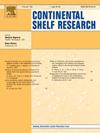伊比利亚西北部近海上升流分离的卫星证据
IF 2.1
3区 地球科学
Q2 OCEANOGRAPHY
引用次数: 0
摘要
利用高分辨率海表温度(SST)和叶绿素 a(Chl-a)图像序列以及数值模式解,研究了在间歇性上升流顺风条件下这两个变量的时空变化。结果表明,陆架上的跨岸 SST 和 Chl-a 剖面的演变与风事件的强度、持续时间和时间间隔有关。该模式对跨岸海温的逼真再现支持了这样一种解释,即在内侧陆架,观测到的变化受上升流离岸辐散的影响,而在陆架中部,则受离岸埃克曼输送和中尺度环流的影响。在风压最大的日子里,沿岸观测到以 30 米和 50 米等深线为界的低海温/低 Chl-a 带,这与模型对较冷的表层下水域的解法相吻合,构成了上升流从海岸分离的卫星证据。这些结果与之前关于浅水、直线海岸线和缓坡上升流的研究结果非常吻合,但在葡萄牙西北部近海的研究区域尚未见报道。这些证据表明,需要使用高分辨率(1 千米)数值模型/图像来正确评估该区域的内 陆环流以及对海洋生态系统的影响,即海洋生物或污染物的近海迁移。本文章由计算机程序翻译,如有差异,请以英文原文为准。

Satellite-based evidence of upwelling separation off NW Iberia
A high-resolution image sequence of sea surface temperature (SST) and Chlorophyll-a (Chl-a), together with numerical model solutions, is used to study the spatio-temporal variability of the two variables under intermittent upwelling-favourable winds. It is shown that the evolution of the cross-shore SST and Chl-a profiles over the shelf is linked to the intensity, duration and temporal separation between the wind events. The model's realistic representation of the cross-shore SST supports the interpretation that the observed variability is governed, in the inner-shelf, by the offshore separation of upwelling divergence and, over the mid-shelf, by offshore Ekman transport and mesoscale circulation. The observation of an alongshore low SST/low Chl-a band, bounded by the 30 m and 50 m isobaths, for the days of maximum wind stress, matching the model's solution for the outcrop of colder subsurface waters, constitute a satellite-based evidence of upwelling separation from the coast. The results are in close agreement with previous works on upwelling in shallow waters, straight coastline and gentle slope, but were not yet reported in the study area off NW Portugal. This evidence prompts for the need to use high-resolution (<1 km) numerical models/imagery to properly assess the inner-shelf circulation in the region, and the effects on the marine ecosystem, namely the offshore transport of marine organisms or pollutants.
求助全文
通过发布文献求助,成功后即可免费获取论文全文。
去求助
来源期刊

Continental Shelf Research
地学-海洋学
CiteScore
4.30
自引率
4.30%
发文量
136
审稿时长
6.1 months
期刊介绍:
Continental Shelf Research publishes articles dealing with the biological, chemical, geological and physical oceanography of the shallow marine environment, from coastal and estuarine waters out to the shelf break. The continental shelf is a critical environment within the land-ocean continuum, and many processes, functions and problems in the continental shelf are driven by terrestrial inputs transported through the rivers and estuaries to the coastal and continental shelf areas. Manuscripts that deal with these topics must make a clear link to the continental shelf. Examples of research areas include:
Physical sedimentology and geomorphology
Geochemistry of the coastal ocean (inorganic and organic)
Marine environment and anthropogenic effects
Interaction of physical dynamics with natural and manmade shoreline features
Benthic, phytoplankton and zooplankton ecology
Coastal water and sediment quality, and ecosystem health
Benthic-pelagic coupling (physical and biogeochemical)
Interactions between physical dynamics (waves, currents, mixing, etc.) and biogeochemical cycles
Estuarine, coastal and shelf sea modelling and process studies.
 求助内容:
求助内容: 应助结果提醒方式:
应助结果提醒方式:


